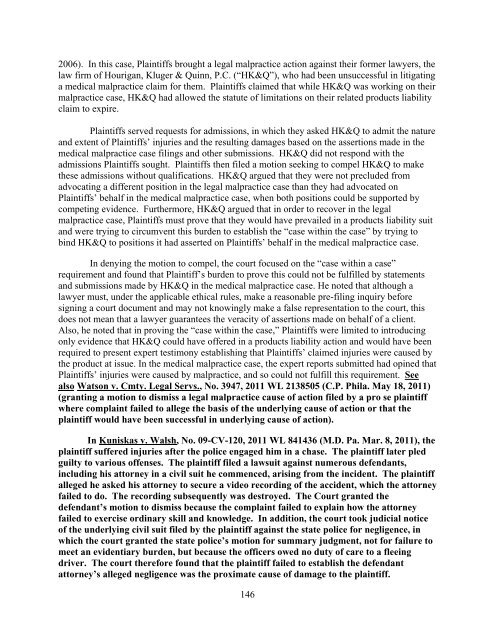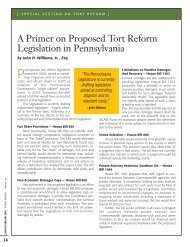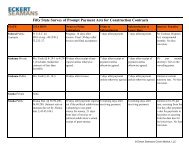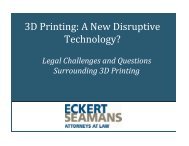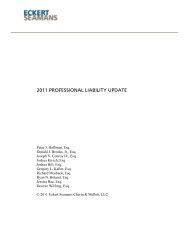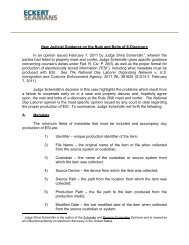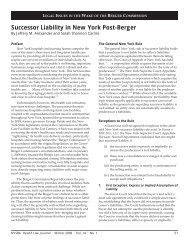2006). In this case, Plaintiffs brought a legal malpractice action against their former lawyers, thelaw firm of Hourigan, Kluger & Quinn, P.C. (“HK&Q”), who had been unsuccessful in litigatinga medical malpractice claim for them. Plaintiffs claimed that while HK&Q was working on theirmalpractice case, HK&Q had allowed the statute of limitations on their related products liabilityclaim to expire.Plaintiffs served requests for admissions, in which they asked HK&Q to admit the natureand extent of Plaintiffs’ injuries and the resulting damages based on the assertions made in themedical malpractice case filings and other submissions. HK&Q did not respond with theadmissions Plaintiffs sought. Plaintiffs then filed a motion seeking to compel HK&Q to makethese admissions without qualifications. HK&Q argued that they were not precluded fromadvocating a different position in the legal malpractice case than they had advocated onPlaintiffs’ behalf in the medical malpractice case, when both positions could be supported bycompeting evidence. Furthermore, HK&Q argued that in order to recover in the legalmalpractice case, Plaintiffs must prove that they would have prevailed in a products liability suitand were trying to circumvent this burden to establish the “case within the case” by trying tobind HK&Q to positions it had asserted on Plaintiffs’ behalf in the medical malpractice case.In denying the motion to compel, the court focused on the “case within a case”requirement and found that Plaintiff’s burden to prove this could not be fulfilled by statementsand submissions made by HK&Q in the medical malpractice case. He noted that although alawyer must, under the applicable ethical rules, make a reasonable pre-filing inquiry beforesigning a court document and may not knowingly make a false representation to the court, thisdoes not mean that a lawyer guarantees the veracity of assertions made on behalf of a client.Also, he noted that in proving the “case within the case,” Plaintiffs were limited to introducingonly evidence that HK&Q could have offered in a products liability action and would have beenrequired to present expert testimony establishing that Plaintiffs’ claimed injuries were caused bythe product at issue. In the medical malpractice case, the expert reports submitted had opined thatPlaintiffs’ injuries were caused by malpractice, and so could not fulfill this requirement. Seealso Watson v. Cmty. Legal Servs., No. 3947, 2011 WL 2138505 (C.P. Phila. May 18, 2011)(granting a motion to dismiss a legal malpractice cause of action filed by a pro se plaintiffwhere complaint failed to allege the basis of the underlying cause of action or that theplaintiff would have been successful in underlying cause of action).In Kuniskas v. Walsh, No. 09-CV-120, 2011 WL 841436 (M.D. Pa. Mar. 8, 2011), theplaintiff suffered injuries after the police engaged him in a chase. The plaintiff later pledguilty to various offenses. The plaintiff filed a lawsuit against numerous defendants,including his attorney in a civil suit he commenced, arising from the incident. The plaintiffalleged he asked his attorney to secure a video recording of the accident, which the attorneyfailed to do. The recording subsequently was destroyed. The Court granted thedefendant’s motion to dismiss because the complaint failed to explain how the attorneyfailed to exercise ordinary skill and knowledge. In addition, the court took judicial noticeof the underlying civil suit filed by the plaintiff against the state police for negligence, inwhich the court granted the state police’s motion for summary judgment, not for failure tomeet an evidentiary burden, but because the officers owed no duty of care to a fleeingdriver. The court therefore found that the plaintiff failed to establish the defendantattorney’s alleged negligence was the proximate cause of damage to the plaintiff.146
In Bayview Loan Servicing, LLC v. Law Firm of Richard M. Squire & Assoc., LLC,No. 10-1451, 2010 WL 5122003 (E.D. Pa. Dec. 14, 2010), the plaintiff acquired the mortgageof an individual who later defaulted on the mortgage. The plaintiff retained the defendantsto commence a foreclosure action and obtained an in rem judgment and a judgmentagainst the individual in the amount of $287,992.56. The property was sold at a sheriff’ssale. The plaintiff later instructed the defendants to seek a deficiency in the amount of$374,998.01 against the individual. Defendants filed the lawsuit but failed to file a petitionto fix a fair value within six months of the sheriff’s sale, which is required in a deficiencyaction. The judgment in the foreclosure action was marked satisfied based on the failure tofile the required petition to fix fair value. The deficiency action also was dismissed. TheUnited States District Court for the Eastern District of Pennsylvania found the complaintsufficiently alleged the defendant’s malpractice caused the plaintiff’s injury where thecomplaint alleged the property was sold below market value, the individual owed theplaintiff in excess of $377,499.00 as a deficiency, the plaintiff instructed the defendants topursue the resulting deficiency, the defendants failed to file a petition to fix fair value,which is required when pursuing a deficiency, and, as a result of the defendants’ failure,the plaintiff suffered damages.In cases involving negligent representation in a criminal proceeding the PennsylvaniaSuperior Court has set forward the following elements needed to establish a legal malpracticeclaim:(1) The employment of the attorney;(2) Reckless or wanton disregard of the defendant’s interest onthe part of the attorney;(3) The attorney’s culpable conduct was the proximate cause ofan injury suffered by the defendant/plaintiff, i.e., “but for” theattorney’s conduct, the defendant/plaintiff would have obtainedan acquittal or a complete dismissal of the charges.(4) As a result of the injury, the criminal defendant/plaintiffsuffered damages.(5) Moreover, a plaintiff will not prevail in an action incriminal malpractice unless he has pursued post-trial remediesand obtained relief which was dependant on attorney error;additionally, although such finding may be introduced intoevidence in the subsequent action it shall not be dispositive ofculpable conduct in the malpractice action.Bailey v. Tucker, 621 A.2d 108 (Pa. Super. Ct. 1993); see also Telepo v. Martin, 257 F.R.D. 76(E.D. Pa. 2009) (case remanded to state court to determine if a cause of action exists whenattorney negligence causes sentencing error.)147
- Page 3 and 4:
EMTALA CASES ......................
- Page 5:
Filing an Affidavit of Non-Involvem
- Page 8 and 9:
II.PROFESSIONAL LIABILITY - AN OVER
- Page 10 and 11:
The Superior Court reversed the tri
- Page 12 and 13:
to a third party pursuant to the st
- Page 14 and 15:
After approximately five months, De
- Page 16 and 17:
learned the day after the surgery t
- Page 18 and 19:
conduct to the delay in colon cance
- Page 20 and 21:
court admitted the expert’s testi
- Page 22 and 23:
(b)(c)other reasonable causes, incl
- Page 24 and 25:
corroborated his testimony. The cou
- Page 26 and 27:
husband’s estate. Plaintiff alleg
- Page 28 and 29:
Other notable federal cases arising
- Page 30 and 31:
The Superior Court found that in re
- Page 32 and 33:
§ 1303.512(b). The court, however,
- Page 34 and 35:
In Neidig v. United States, No. 07-
- Page 36 and 37:
Additionally, the Supreme Court not
- Page 38 and 39:
were not indicated for her conditio
- Page 40 and 41:
surgeon is the same as it would be
- Page 42 and 43:
It should be noted that the Superio
- Page 44 and 45:
Finally, the court held that the tr
- Page 46 and 47:
The Supreme Court of Pennsylvania r
- Page 48 and 49:
nurses deviating from applicable st
- Page 50 and 51:
certainty, the court reviews expert
- Page 52 and 53:
Under Pennsylvania law, the Court n
- Page 54 and 55:
testimony, Defendant presented his
- Page 56 and 57:
Following Cooper v. Roberts, 286 A.
- Page 58 and 59:
Plaintiff developed chronic diarrhe
- Page 60 and 61:
where payment is made by Medicaid w
- Page 62 and 63:
accomplished. In Valles v. Albert E
- Page 64 and 65:
In 1980, the Pennsylvania Superior
- Page 66 and 67:
Plaintiff had a routine monitoring
- Page 68 and 69:
Plaintiff’s Contract ClaimsThe Co
- Page 70 and 71:
is a failure to report changes in a
- Page 72 and 73:
unit to assure post-surgical patien
- Page 74 and 75:
sliced his wrist and arm with a raz
- Page 76 and 77:
licensed professionals for whom the
- Page 78 and 79:
(c)Limitations of Corporate Neglige
- Page 80 and 81:
Even more recently, our Superior Co
- Page 82 and 83:
(a)HMO IssuesIn McClellan v. Health
- Page 84 and 85:
affidavit submitted by Defendants o
- Page 86 and 87:
treatments while at VA’s faciliti
- Page 88 and 89:
[s]ubstantively, we believe that a
- Page 90 and 91:
The party claiming the benefit of t
- Page 92 and 93:
deprive (him) of civil rights guara
- Page 94 and 95:
found that the District Court was w
- Page 96 and 97:
With respect to fraudulent concealm
- Page 98 and 99:
would be applied in situations wher
- Page 100 and 101:
they had not raised them in the cou
- Page 102 and 103: (a)Informed ConsentUnder MCARE, a p
- Page 104 and 105: civil enforcement provisions and ma
- Page 106 and 107: MCARE also changes the manner in wh
- Page 108 and 109: whose death, in 2005, was allegedly
- Page 110 and 111: vicariously liable if the plaintiff
- Page 112 and 113: health center or its equivalent or
- Page 114 and 115: In Pennsylvania Medical Society, th
- Page 116 and 117: to any professional who is alleged
- Page 118 and 119: Since the 2005 amendments, there ha
- Page 120 and 121: ule, but who intentionally ignores
- Page 122 and 123: the original Complaint was delivere
- Page 124 and 125: foreclose all challenges against th
- Page 126 and 127: number of boxes), which was support
- Page 128 and 129: questions of professional judgment
- Page 130 and 131: deviated from any professional stan
- Page 132 and 133: The Third Circuit affirmed the Dist
- Page 134 and 135: claims and cross-claims remain agai
- Page 136 and 137: By an Amendatory Order dated March
- Page 138 and 139: The court acknowledged that there i
- Page 140 and 141: apply and that the trial court misa
- Page 142 and 143: Barbados had enough litigation-spec
- Page 144 and 145: E. Preemption of Vaccine Design Def
- Page 146 and 147: 2. Pa. R. Civ. Pro. 1036.1 - Reinst
- Page 148 and 149: Barrick, at *34-35.Furthermore, the
- Page 150 and 151: (b) the utility of the defendant’
- Page 154 and 155: B. Elements of a Cause of Action fo
- Page 156 and 157: decision in Muhammad precluded Mr.
- Page 158 and 159: considered speculative “only if t
- Page 160 and 161: underlying cause of action involved
- Page 162 and 163: In Capital Care Corp., the Superior
- Page 164 and 165: The court found, however, to state
- Page 166 and 167: of reasonable diligence. The standa
- Page 168 and 169: not be set aside. On July 7, 2005,
- Page 170 and 171: complete bar to recovery. Since a l
- Page 172 and 173: On appeal, Plaintiffs claimed that
- Page 174 and 175: In Liggon-Redding, 659 F.3d at 265,
- Page 176 and 177: elieved of those minimum standards
- Page 178 and 179: elevant to the proceedings, the com
- Page 180 and 181: establish professional misconduct b
- Page 182 and 183: Upholding the Superior Court’s Or
- Page 184 and 185: Id.Rejecting revocation and suspens
- Page 186 and 187: order as a sanction under Rule 4019
- Page 188: {1009912]182


